| By: Paul S. Cilwa | Viewed: 4/23/2024 Posted: 4/18/2006 |
Page Views: 7453 | |
| Topics: #AlienAbductions #Nibiruans #Sumerians #ZechariaSitchin | |||
| There is an impressive amount of evidence supporting the idea that extraterrestrials have been behind Human advancement since the birth of our species. | |||
Michael quit his job for Soloman Brothers in World Trade Center Building 7, and moved in with me, in March, 1997. We made a trip together to Arizona and put down a payment on property in Snowflake in July, then drove a trailer full of our stuff across the country in September. The Snowflake property had an old single-wide mobile home on it that we'd been told was habitable. After four months we had to admit it wasn't, and moved into a rental home a few miles away. We also rented office space in town, since there wasn't room in the house for desks, computers, books, and so on. And, most every week, Michael drove me to Phoenix to catch a flight for wherever I was teaching that week, or to pick me up when I arrived from my previous week's class.
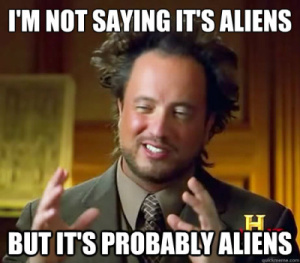
All this time, I was very jumpy. Every time I got a "strange feeling" I would blame it on aliens. Every time something was missing, I would suspect aliens. But the fact was, nothing unambiguous could be pinned on them. There was no evidence they'd been around since they'd said goodbye.
Michael owned hundreds of books on most every subject, but particularly on metaphysics. He hadn't even read all of them, though he generally knew the gist of their contents. Among them was a full set of Zecharia Sitchin's "Earth Chronicles" series.
The only reason I'd heard of the first book in this series, The 12th Planet, was that it had been recommended to me by several of my friends in the Support Group. Nevertheless, I'd never read it. Now, I took it with me on a flight and read it through that week.
Sitchin was an expert in Hebrew and other Semitic languages, who had committed the unforgivable sin of doing scholarly work in a field in which he held no university degrees. (His degree, from the University of London, is in economics.) However, most linguists will grudgingly admit that only an outsider could do the work he had done.
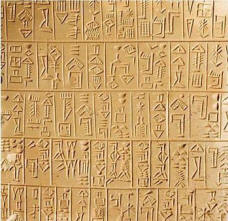
In 1835, archeologist Henry Rawlinson discovered a number of ancient, written tablets in the country now known as Iraq. These tablets were eventually identified as being from the Kingdom of Akkad, and were translated. The script used to write these tablets was called cuneiform, and was written by pressing reed styluses into mud. When dried, the tablets were remarkably durable—they'd been buried almost 2500 years.
Subsequently, Rawlinson dug up tablets from a different, older site he identified as being a city of the Kingdom of Sumer, or Sumeria. Those tablets were also written in cuneiform, but the language was different. Akkadian was a syllabic language (meaning the cuneiform characters were strung together to represent sounds and syllables); Sumerian was agglutinative, meaning that its letters created words by tying together morphemes via meaning, not sound.
When linguists translate an ancient language for the first time, they need a "Rosetta Stone" as a tool. (The original Rosetta Stone bore an inscription in Greek and two variants of Egyptian. Since Greek and the Demotic variant of Egyptian was well-understood, it was a simple matter to identify the meanings of the corresponding hieroglyphic Egyptian words.)

But a Rosetta Stone is just a starting point, unless by unimaginable luck it is actually a dictionary. (No such Rosetta Stone has ever been found. It would be a big stone.) So what linguists do, is map the words on the unknown language side to the known language, and then look for another document that has a lot of the same previously-unknown words. You then replace the unknown words with their guessed-at meanings. That gives you a tablet containing some words you think you know, and a lot of words you don't know scattered between them. You now, using nothing but guesswork, fill in the blanks with words that seem to make sense, given the words you do know.
That gives you a document that contains words you probably know, and others you may know. You now go to another document, and again fill in the blanks. Some of the words you guessed at will still make sense, so your level of confidence that this is, in fact, the actual meaning of that ancient symbol rises. Others will not make sense, so you erase them and make a new guess.
When a tablet was discovered that contained both Akkadian and Sumerian writing, that was the long-sought Sumerian Rosetta Stone and translators went to work. The majority of translation work was completed by 1908.
Or was it? Linguists who trained in Sumerian were now handed a Sumerian dictionary and a "correct" translation that agreed with the dictionary, with no way to verify whether it was accurate or not. Sitchin, coming in fresh, was quick to see that certain translations made no sense. One was the Sumerian word mu. This word, according to the official dictionary, means "name". Sumerians, we are told by their own tablets, built a structure so they could send their "names" to heaven. Yet, in other passages, Sumerian gods climb into their "names" and ride them to other planets.

A significance the original translators couldn't have known, is the very appearance of the cuneiform symbol for GER: it looks just like the nose cone of a modern multi-stage rocket. Moreover, the symbol "fits" atop another symbol that the traditional Sumerian dictionary claims means "stones that rise". The combination looks like a sketch made at NASA back in the 1970s, when the lunar flights were taking off.
Now if Sitchin had made these statements and shut up, he'd have merely been ignored. However, he didn't stop there. He retranslated the Sumerian tablets using his new dictionary and came up with an easy-to-read and perfectly coherent story of interplanetary colonization by aliens, and the subsequent creation of our species, Homo sapiens, by those aliens to serve as their slaves.
Lots of people have come up with cockamamie theories and nothing ever becomes of them—a book appears, people read it, and it's forgotten within a decade. However, Sitchin inspired an unbelievable amount of debunking. The only time I'd ever seen the trashing of a man's reputation taken to this level was in the books falsely debunking UFO sightings and abductions. That made me think that: 1) Sitchin's interpretation was likely to be true, and 2) there might actually be some kind of conspiracy trying to keep the entire alien connection to mankind secret.
And if Sitchin were right, and aliens had genetically engineered our species—and if those same aliens were the ones doing the abductions—wouldn't there logically be an organization devoted to suppressing this information? Wouldn't that organization be headed by those very same aliens?
After all, isn't the most certain way of preventing a slave revolt to convince the slaves they are already free?
In any case, reading this book—which I had not expected to convince me—brought me into contact with the word "Nibiruan" that I had first heard during one of the night classes given by aliens. I had never heard the word before and, in 1997, was unable to find it defined anywhere…but I hadn't looked in Sitchin's books. There, I discovered that the "gods" of the Sumerians had claimed an origin from a world they called Nibiru, which is Sumerian for "planet of the crossing."
Looking outside the book, I found that there were definitely mysteries regarding Sumer and its rapid (and unexpected) rise as a civilization. These people had, apparently, invented language, cities, agriculture, architecture, metalwork, medicine, law, religion, literature, and astronomy. It's essential to picture the world before Sumer as seen by conventional paleontologists: A natural world in which our ancestors were in the middle of the food chain, living in caves or perhaps huts, wearing animal skins and clinging precariously to the edge of extinction. Then, suddenly, out of nowhere—the Sumerian cities of Ur, Nippur, Eridu and others sprung up, with the complex infrastructure of farming, trade, trade routes, kingship and merchants to support them.
In conventional histories, you can read the author exhorting us to "remember the Sumerians" and give them their due for creating virtually everything we have today. But is it reasonable to credit the Sumerians with all this, when the Sumerians themselves credited visitors from the skies who, they say, taught them all these things?
The premise that the Sumerians were, indeed, given knowledge by advanced aliens can easily be tested. If true, that knowledge should be more correct than otherwise possible…and, sure enough, their astronomical tables include accurate orbital information for all the planets, including Uranus, Neptune, and even Pluto—the three planets of our Solar System that are not visible to the naked eye. (They were not re-discovered until 1781, 1846, and 1930, respectively.) Even the major moons of Jupiter, re-discovered by Galileo in 1610, were known to the Sumerians!
This proof of their scientific knowledge demands that we take their other stories, if not at face value, at least with an open mind and willing attitude.
The Sumerians' Story
According to the Sumerians, the "gods" were beings who looked much like us (we were created "in their image") but came from a world far from the Sun that they called Nibiru. In Sumerian, NI.BI.RU means "planet of the crossing;" they named their world that because, every 3600 years, it crossed from the outer depths of the Solar System into its inner reaches—it had, in other words, an extremely elliptical orbit, like that of a comet.
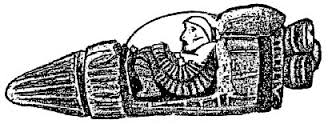
Some 450,000 years ago, according to the Sumerians' timeline, a Nibiruan fled from his home world to Earth. Nibiru was having some sort of environmental crisis, which required finely ground gold dust to rectify. When this Nibiruan, called Alalu, discovered that Earth was rich in the yellow metal, he put aside past differences and contacted his home world.
Within five thousand years, the Nibiruans (who are extremely long-lived and make decisions with glacial deliberation) were able to mount a massive space program and send 500 astronauts to Earth to extract gold from the waters of what is now the Persian Gulf. These astronauts, called the Anunaki (meaning, "Those Who To Earth From Heaven Came"), are the "giants" of the Old Testament, the "Sons of God" who married the "daughters of men." However, that is getting way ahead of the story; for, according to the Sumerians, mankind had not yet been created.
By 416,000 years ago, it became evident to the Nibiruans that extracting gold from seawater was too inefficient a process to save their home world in time, and the order came to mine it instead. (There are, in fact, the remains of extremely ancient gold mines in South Africa, whose age defies analysis.) The Anunaki, hired to be spacemen and lab techs, found themselves pressed into service as miners. The work was hard and intolerable to them; still, in true Nibiruan fashion, they endured it for well over 100,000 years before mutinying.
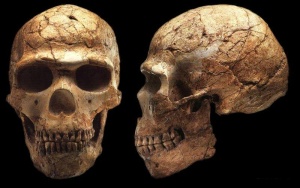
In response to the mutiny, a Nibiruan named Ninhursag used genetic manipulation to combine the genes of "ape-woman" (probably Homo Erectus) and Nibiruans to produce Man (Cro-Magnon, or anatomically modern, humans). This happened, according to the Sumerians, about 300,000 years ago somewhere near Africa's Rift Valley. Until recently, this date would have sounded much too soon for the appearance of modern humans; but recent finds of extremely old anatomically-modern human skeletons have made it plausible.
At first, the genetically altered humans were sterile and had to be artificially carried to term by Nibiruan "birth goddesses," chosen from among the Anunaki, who apparently found that type of labor preferable to working in the mines. Obviously, though, this means of producing workers was inherently inefficient. Enki, the Nibiruan whose idea all this was, broke ranks and secretly further manipulated the genes of the workers, making it possible for them to procreate.
An amazing aspect of this story is that the first workers were given the task of tending a garden. Where was it? The Sumerian name was E.DIN. (Yes, Eden!) What's more, the "Tree of Knowledge" takes on special significance when we remember that "knowing" is a Biblical euphemism for sex…and when we find out that Enki's "trademark" or symbol was…the serpent!
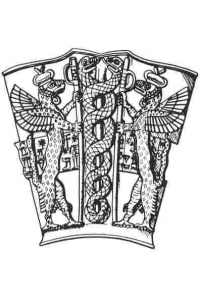
Symbolism of Enki, the Nibiruan genetics expert in charge of the ADAM Project.

The modern symbol of medicine, derived from Enki's symbol.

Representation of DNA, the building blocks of all life on Earth.
By 100,000 years ago, mankind's place in this colony world of Nibiru seemed secure. Many of the Anunaki—called nefilim in Hebrew, translated "giants" in the King James Version of The Bible—took for themselves wives and husbands from among the humans; the job of genetic manipulation had been so thorough that the mixed couples could even bear children. This practice was looked upon by the Nibiruan leaders with alarm, however. Some also doubted the use of another species for service was good for the Nibiruans' own long-term welfare. Some Nibiruans began to wonder if it might ever be possible to close this particular can of worms.
The Flood

By 75,000 years ago, the most recent ice age gripped Earth. It was fourth in a series, but the first in the Nibiruans' experience. Sea levels fell; once-lush areas became deserts; temperatures dropped. The glaciers of the world grew, and grew, and grew. By about 13,000 years ago, the seas had fallen to 200 feet below their present level, and the glaciers covering Antarctica had reached critical mass. Almost any celestial jiggling could send them plunging into the oceans; and one was on its way: Nibiru, approaching from its eccentric orbit, was about to pass near Earth on its 3600-year orbit, carrying with it an entourage of displaced comets.
It was not hard for Nibiruan scientists to calculate that the collapsing ice shelves of Antarctica would produce a world-wide tsunami, or even when; the Nibiruans were hastily called into orbit, forced to leave their human husbands and wives, even prevented by oath from warning them of what was about to befall. One Nibiruan, however—our friend, Enki—told his favorite human anyway. That human, known as Ziusudra to the Sumerians and Noah in Hebrew, and who was, in fact, Enki's son, was instructed to build a submersible vessel and to wait there with his family and genetic samples of all Earthly animals and pairs of animals of various genera to serve as surrogate parents so that Earth's fauna could be restored after the global inundation.
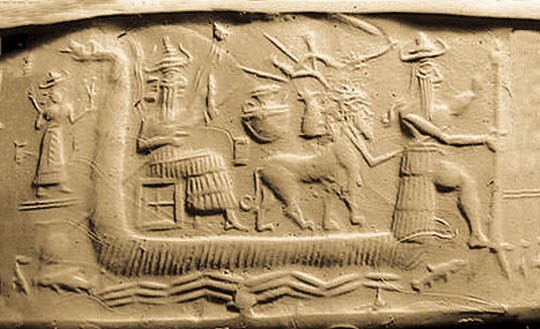
Sumerian tablet depicting the Great Flood.
The igigi, Nibiruan astronauts who maintained an orbiting space station, were not prepared to support hundreds of displaced Anunaki; food supplies ran low and it was a hungry group of Nibiruans who landed on the soggy Earth after many weeks of flood. They might well have been upset to find surviving humans…if the humans hadn't had food with them. The Anunaki, and even Enki's nemesis and half-brother Enlil, grudgingly acknowledged that the Nibiruan/human alliance was here to stay.
Nibiruans could only commute to and from their home world when it was near the Sun—otherwise, it was just too long a journey. That happened about every 3600 years. In each of the next few of these Nibiruan years, according to the Sumerian sources, humans were "given" new technologies: First, agriculture; then, domesticated animals that provided humans with servants as humans served the Nibiruans. Finally, cities were introduced as support for armies of Nibiruans, and individuals fought for control and position.
The Sumerians recorded the loosening of buried gold by the Deluge, so that placer mining could be conducted in South America (and South American records document the visitation of bearded white men from the East with a fascination for gold). They recorded the Pyramid Wars, and even described the granite plug found in the Great Pyramid and explained why no mummies were ever found in these supposed "tombs." They described the result of nuclear fallout on the cities of their civilization (and the remains of cities have been found there that were "chopped off at the foundation," all walls smashed in the same direction, as would happen in a nuclear blast).
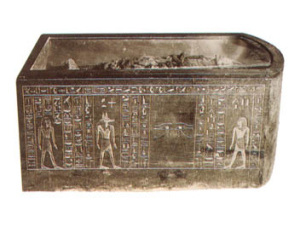
The Egyptians were very much "into" death, and decorated their sarcophagi with images and instructions for getting on in the afterlife.
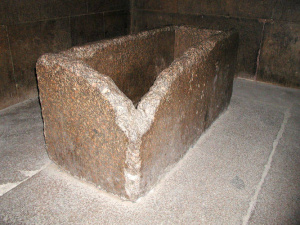
There were no decorated sarcophagi in any of the Great Pyramids tubs. They were only assumed to be sarcophagi because the pyramids were believed to be tombs. But the lack of decoration proves they are not sarcophagi, and therefore the Great Pyramids are not tombs. (Other pyramids, built millennia later, are.)
By 2023 BCE, the winds carried the radioactive cloud to Sumer. People died a terrible death; animals perished; the water was poisoned; the soil became barren. Sumer and its great civilization lay prostrate. Its legacy passed to Abraham's seed as he begot—at age 100—a legitimate heir: Isaac.
Consider, however, that mu—the word that Sitchin insists means "rocket ship"—could also refer to the people who flew the ships. The Sumerian word mu is equivalent to the Hebrew word shem. According to the Bible, Abraham was descended from Noah's (Ziusudra's) son, Shem, who was presumably a pilot, since people used to name themselves after an accomplishment. Abraham was the ancestor of the people who include the Jews and Arabs, the Semites. "Semite" is derived from "Shem." This would identify the Chosen People as the people chosen by the makers of the rockets.
Is there any evidence that Homo sapiens differs in some significant, genetic way from other creatures on Earth?
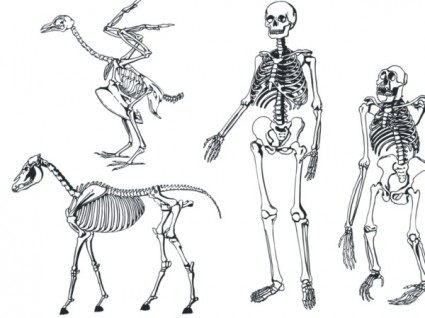
Certainly our bones do not. All earth species with backbones, have skeletal structures based on the same basic plan. Our hands and feet are amazingly similar to fishes' fins, horses hooves, and seals' flippers.
However, in 2001 Science magazine formally announced the conclusion of the Human Genome Project, a study designed to identify the makeup of every gene in human DNA. Originally it had been expected that this mapping would take centuries; but the unexpected advances in computers—combined with the fact that humans don't have as many more genes than a flatworm as the original researchers had supposed—brought it to completion at the start of the 21st century.
Meanwhile, the same techniques had been rapidly cataloging the DNA of dogs, horses, monkeys, and other species; so that when the Human Genome Project was completed, it was possible to put what scientists on the project had learned in context.
And what did they learn?
That most species differ from other, similar species by just one or at most two genes…but humans differ from our nearest relatives by no fewer than 223 genes! —What's more, all 223 of those genes are concerned with human brain growth and psychology.
It was clear to me that those 223 genes represented the difference between our immediate ancestor, Homo erectus, and our own species, Homo sapiens. I was convinced when the spinners came out of the woodwork and announced the number of 223 was "wrong". There weren't that many new genes, they said, and most of them had been "transferred" by means unspecified, from bacteria (also unspecified) to us. Note, this information didn't come from the scientists who made the original report. This was nothing less than spin, disinformation distributed for no other purpose than to mislead us.
But, if the Nibiruans spent so much time manipulating the affairs of humans, literally half a million years…where did they go? That was the next mystery to solve.





